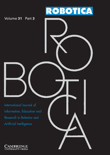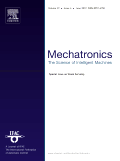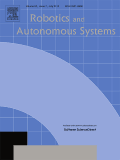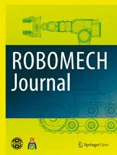
ROBOTICA
Scope & Guideline
Pioneering Discoveries in Multidisciplinary Robotics
Introduction
Aims and Scopes
- Robotic Mechanisms and Kinematics:
Research on the design, analysis, and optimization of robotic mechanisms, including parallel and serial manipulators, with a focus on their kinematic performance and workspace. - Control Systems and Algorithms:
Development and implementation of advanced control algorithms for robotic systems, including adaptive control, model predictive control, and fuzzy logic controllers. - Soft Robotics and Bioinspired Designs:
Exploration of soft robotic systems and bioinspired mechanisms that mimic natural movement, including the design and control of compliant actuators and robotic limbs. - Human-Robot Interaction and Collaboration:
Studies aimed at enhancing the interaction between robots and humans, focusing on collaborative robots (cobots) and the development of intuitive control strategies. - Autonomous Systems and Navigation:
Research related to the autonomous operation of robots, including path planning, localization, and navigation in dynamic and unstructured environments. - Rehabilitation Robotics:
Innovations in robotic systems designed for rehabilitation purposes, including exoskeletons and assistive devices, with a focus on improving human mobility and recovery. - Robotic Applications in Industry and Healthcare:
Application-driven research that investigates the use of robotics in various sectors, particularly in industrial automation and healthcare settings.
Trending and Emerging
- Machine Learning and AI in Robotics:
The integration of machine learning algorithms and artificial intelligence in robotics is trending, facilitating enhanced autonomy and decision-making capabilities in robotic systems. - Collaborative and Social Robotics:
Research focusing on the development of robots that can work alongside humans in shared environments, enhancing productivity and safety in various applications. - Soft Robotics and Bioinspired Technologies:
There is a growing interest in soft robotics that emphasizes flexibility and adaptability, inspired by biological systems, which opens new possibilities for applications in delicate environments. - Robotics for Health and Rehabilitation:
Emerging research on robotic systems tailored for health applications, particularly rehabilitation robotics, aims to improve patient outcomes and enhance mobility. - Robotics in Unstructured Environments:
Increased focus on robots operating in unstructured and dynamic environments, such as search and rescue operations or exploration tasks, highlighting the need for advanced navigation and adaptability. - Multi-Robot Systems and Coordination:
Research on coordinated control and task allocation among multiple robots is gaining traction, particularly for applications in logistics, agriculture, and surveillance.
Declining or Waning
- Traditional Industrial Robotics:
Research focused primarily on traditional industrial robots for manufacturing has seen a decline as the field shifts towards more versatile and intelligent robotic systems. - Basic Robotic Control Techniques:
Fundamental control techniques that lack adaptability and learning capabilities are becoming less prominent, as there is a growing focus on advanced and adaptive control methods. - Static Path Planning:
Static path planning methods that do not account for dynamic environments are waning in favor of more sophisticated approaches that incorporate real-time adaptability. - Legacy Robotic Systems:
Research on older robotic architectures and systems is decreasing as newer, more efficient, and capable robotic platforms emerge.
Similar Journals

MECHATRONICS
Connecting Disciplines, Shaping the Future of EngineeringMECHATRONICS is a prominent journal published by PERGAMON-ELSEVIER SCIENCE LTD, focusing on the interdisciplinary fields of mechanical engineering, control and systems engineering, electrical and electronic engineering, and computer science applications. With an ISSN of 0957-4158, this journal has been a cornerstone in advancing knowledge and innovation since its inception in 1991. Known for its rigorous peer-review process and high-quality research outputs, MECHATRONICS holds prestigious rankings, including Q1 in both Electrical and Electronic Engineering and Mechanical Engineering for the year 2023, reflecting its influential position in the academic community. The journal caters to a diverse audience of researchers, professionals, and students, making it an essential resource for those looking to stay at the forefront of technological advancements in mechatronic systems. Although it does not currently offer open access, its wealth of insights and findings is indispensable for anyone pursuing excellence in engineering methodologies and applications.

INTERNATIONAL JOURNAL OF ROBOTICS RESEARCH
Fostering Groundbreaking Research in RoboticsINTERNATIONAL JOURNAL OF ROBOTICS RESEARCH (ISSN: 0278-3649, E-ISSN: 1741-3176), published by SAGE PUBLICATIONS LTD, is a leading journal in the fields of robotics and engineering. With an impressive impact factor and recognized as a Q1 journal in various categories including Applied Mathematics, Artificial Intelligence, Electrical and Electronic Engineering, Mechanical Engineering, Modeling and Simulation, and Software, it has established itself as an essential resource for researchers and practitioners alike. The journal covers a wide array of topics relevant to the advancing disciplines of robotics, ensuring comprehensive perspectives on both theoretical and practical applications. Notably, it ranks at the top percentile in Scopus rankings across multiple fields, which underscores its significance in the research community. Published continuously since 1982, the journal invites submissions that push the boundaries of robotics research, offering a platform for innovative ideas and solutions that address complex engineering problems. While it operates under a subscription model, its vast reach and reputation make it an invaluable resource for advancing knowledge in robotics.

Industrial Robot-The International Journal of Robotics Research and Application
Connecting Research with Real-World Robotics ApplicationsIndustrial Robot-The International Journal of Robotics Research and Application is a premier academic journal published by Emerald Group Publishing Ltd in the United Kingdom. Since its inception in 1973, the journal has established itself as a critical resource for the advancement of knowledge in the fields of robotics and automation. With an impressive Q2 ranking across several categories, including Computer Science Applications, Control and Systems Engineering, and Industrial and Manufacturing Engineering, it places itself among the top-tier journals in its domain. The journal aims to disseminate high-quality research that addresses contemporary challenges and innovations in robotics, thereby supporting both academic inquiry and practical applications in industry. Researchers, professionals, and students are encouraged to contribute to its mission, as it remains vital for those seeking to engage with the ever-evolving landscape of robotic technologies.

Artificial Life and Robotics
Exploring the Frontiers of AI and BiochemistryArtificial Life and Robotics, published by Springer, is a prominent journal in the fields of Artificial Intelligence and Biochemistry, Genetics, and Molecular Biology, with an ISSN of 1433-5298 and E-ISSN of 1614-7456. Established in 2005, the journal has continually contributed to knowledge and innovation in these rapidly evolving disciplines and is recognized for its significant impact, as indicated by its quartile rankings in the 2023 category assessments. The journal is currently positioned in Q4 for Artificial Intelligence and Q3 for General Biochemistry, Genetics and Molecular Biology, with a notable ranking of 138/221 and 262/350 in respective research areas. While it currently does not follow an open access model, it remains a valuable resource for researchers, professionals, and students seeking to advance their understanding and application of artificial life and robotic technologies. With an emphasis on interdisciplinary research, this journal aims to bridge theoretical foundations with practical applications, making it an essential platform for cutting-edge studies and discussions in the field.

Soft Robotics
Bridging Theory and Application in Flexible Robotics.Soft Robotics, published by MARY ANN LIEBERT, INC, stands as a leading journal dedicated to advancing the field of soft robotics, which merges insights from artificial intelligence, biophysics, and control systems engineering to innovate in areas such as bio-inspired design, human-robot interaction, and flexible robotics. With a distinguished Q1 ranking in multiple categories, including Artificial Intelligence, Biophysics, and Control and Systems Engineering, this journal places itself at the cutting edge of interdisciplinary research, boasting impressive Scopus rankings that reflect its rigorous scholarship and influential contributions to the scientific community. Although it is not an open access journal, it provides valuable insights and findings for researchers, professionals, and students eager to explore the transformative potential of soft robotics in practical applications. The journal has published continuously since its inception in 2014, and will continue to converge between theory and application through 2024, emphasizing its commitment to expanding the frontiers of knowledge in this dynamic field. For those engaged in the exploration of robotics technologies shaped by soft materials and adaptive mechanisms, Soft Robotics is an essential resource that fuels innovation and discovery.

ROBOTICS AND AUTONOMOUS SYSTEMS
Fostering Breakthroughs in Autonomous Research.ROBOTICS AND AUTONOMOUS SYSTEMS, published by Elsevier, is a leading journal in the fields of robotics and automation, providing a platform for the dissemination of high-quality, peer-reviewed research. With an impressive impact factor and a prestigious reputation, this journal is classified in the Q1 category for major fields including Computer Science Applications, Control and Systems Engineering, Mathematics, and Software as of 2023. The journal boasts an extensive archive dating back to 1988, reflecting the evolution of the discipline and fostering innovative research discussions that are crucial for advancements in autonomous technologies. Researchers, professionals, and students are encouraged to contribute to and benefit from the ongoing dialogue within these dynamic fields. Accessible through various academic resources, ROBOTICS AND AUTONOMOUS SYSTEMS stands as a pivotal information source for those dedicated to exploring the frontiers of intelligent systems.

Science Robotics
Catalyzing Tomorrow's Robotic Technologies TodayScience Robotics, published by the American Association for the Advancement of Science, is a leading journal that explores cutting-edge advancements in the field of robotics, emphasizing the intersection of artificial intelligence, mechanical engineering, and control optimization. With its ISSN 2470-9476, this prestigious journal holds an impressive Q1 ranking across pivotal categories for 2023, including Artificial Intelligence, Computer Science Applications, Control and Optimization, and Mechanical Engineering. It has garnered renowned recognition in the academic community, highlighted by its high Scopus rankings—placing it in the top tier with a 99th percentile rank in Mathematics for Control and Optimization and Computer Science Applications, and maintaining a 98th percentile in Artificial Intelligence. While the journal is not currently open access, it serves as a vital repository of knowledge for researchers, professionals, and students seeking to stay at the forefront of robotic innovations. Operating from its base in Washington, DC, Science Robotics aims to disseminate world-class research that catalyzes future developments in robotics and automation technologies, making it an essential resource for those engaged in the scientific study and application of these transformative fields.

INTERNATIONAL JOURNAL OF ROBOTICS & AUTOMATION
Driving Insights in Cutting-edge Technologies.International Journal of Robotics & Automation is a premier academic journal published by ACTA PRESS, dedicated to advancing knowledge and applications in the dynamic fields of robotics, automation, and related engineering disciplines. With a history spanning from 1995 to 2024, this journal serves as a crucial platform for the dissemination of innovative research, offering valuable insights across various categories, including Artificial Intelligence, Control and Systems Engineering, and Mechanical Engineering. Although currently not open access, its rigorous peer-reviewed articles hold significance for researchers, professionals, and students alike, providing a solid foundation for advancements in technology and engineering methodologies. The journal's rankings in Scopus reflect its growing impact, particularly in niche areas of Modeling and Simulation and Software, highlighting the critical need for cutting-edge research and discussion in these developing fields. As the landscape of robotics and automation continues to evolve, this journal remains an essential resource for those seeking to contribute to and engage with the forefront of scholarly research.

ROBOMECH Journal
Advancing Robotics and Mechanical Engineering through Open ResearchROBOMECH Journal, published by SpringerNature, is a prominent open-access journal dedicated to the fields of robotics, mechanical engineering, and artificial intelligence. Established in 2014, the journal has quickly established itself as a vital platform for disseminating innovative research in control and optimization, instrumentation, and modeling and simulation, earning a commendable Q2 ranking in Mechanical Engineering and multiple Q3 rankings across other relevant fields in 2023. With a commitment to facilitating accessible knowledge sharing, ROBOMECH Journal promotes cutting-edge research that drives advancements in both theoretical frameworks and practical applications within the robotics community. Scholars, engineers, and professionals seeking to contribute to or stay informed about the latest developments in these dynamic fields will find the journal's rich array of articles invaluable. With its open-access model, all published research is freely available, ensuring wide dissemination and increased visibility for authors, thus fostering collaboration and innovation across disciplines.

Journal of Robotics
Driving Collaboration in Cutting-Edge RoboticsJournal of Robotics, published by HINDAWI LTD, is a premier open-access journal dedicated to the rapidly evolving field of robotics. With its ISSN 1687-9600 and E-ISSN 1687-9619, the journal has been an essential resource for researchers, professionals, and students since its establishment in 2009. Based in England, the journal not only aims to disseminate cutting-edge research but also provides a platform for critical discussions on the latest advancements in robotics. Recognized for its quality, the journal holds a Q2 ranking in Computer Science (miscellaneous) and a Q3 ranking in Control and Systems Engineering for the year 2023. Spanning topics from autonomous systems to robotic engineering, the Journal of Robotics is indexed in various esteemed databases, making it a credible source for innovative research. The journal's commitment to open access ensures that its research reaches a broad audience, encouraging collaboration and driving forward the boundaries of technology and engineering.